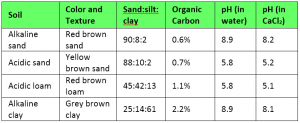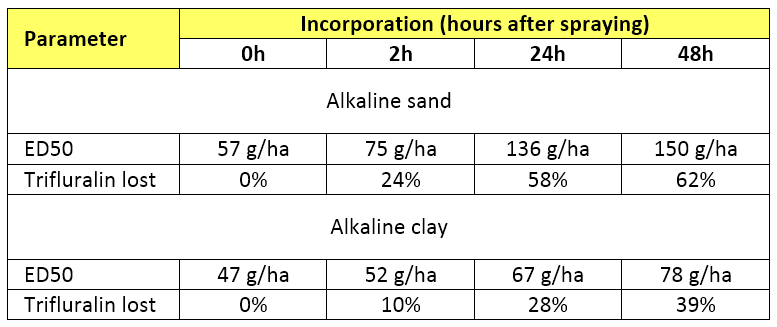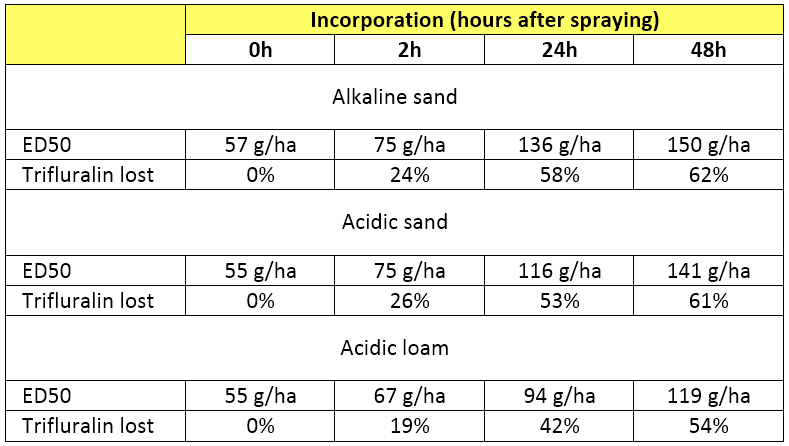In Part 1 of this series we explained how:
- trifluralin stops weed growth by inhibiting the division of cells at the root tip,
- trifluralin vapour moves very short distances through soil and so vapour movement won’t compensate for poor application,
- trifluralin is primarily absorbed into grasses through the roots rather than the coleoptile and so is far more potent when applied to the weed’s root zone,
- volatilisation can cause the loss of more than 60% of applied trifluralin and,
- studies have shown that trifluralin loses due to UV degradation have been low, generally less than 5% even under high UV conditions.
In this article we will review how soil type and soil pH affects the efficacy of trifluralin.
Please note that the scientific methods used in the experiments described here are too lengthy for this article. Please contact me if you want more information on these studies.
Soil types used in studies
The studies reported in this article were conducted on four soil types collected from fields in Australia’s wheat belt (Table 1).

Table 1. Soil pH, color, texture and composition of the four soils used in trifluralin studies.
Effect of soil type on trifluralin efficacy and volatilisation losses
Both the efficacy and the volatilisation losses of trifluralin are affected by soil type.
This study compared the emergence of annual ryegrass from two soils that had a very similar pH but very different texture – an alkaline sand and an alkaline clay. Ten rates of trifluralin were sprayed onto the soils in eight replicates of 5cm deep plastic punnets. The trifluralin was left on the soil surface for; 0, 2, 24 or 48 hours before being thoroughly incorporated. After all treatments had been incorporated the pots were sown with non-herbicide resistant, annual ryegrass and moved to a temperature controlled greenhouse.
Results and Discussion
Table 2 summarises data from the dose response curves and is presented as the ED50 (the Effective Dose that reduced the emergence by 50%) and the calculated trifluralin lost.

Table 2. Effect of soil type and time to incorporation on the ED50 of annual ryegrass emergence and trifluralin loss. Soils were an alkaline clay and an alkaline sand. Percent trifluralin loss is based on dose response analysis, data was not included in this article.
When the trifluralin was incorporated immediately after application (0h) trifluralin was 21% more effective at reducing emergence of ryegrass in the alkaline clay than in the alkaline sand.
There was much less volatilisation from the clay with 39% of the trifluralin being lost from the clay in 48 hours compared to 62% from the sand.
Trifluralin is known to have a far greater affinity for organic matter than for other soil components such as clay, silt and sand. It is also known to have a stronger affinity for clay than sand but the difference between clay and sand is much less than between organic matter and clay.
The alkaline clay had an organic carbon content of 2.2% compared with 0.6% for the sand (Table 1). It is not surprising therefore that volatility was less from the soil with the greater amount of organic matter.
There is still speculation as to why, when the chemical is incorporated thoroughly into the soil immediately after spraying, the efficacy of trifluralin is lower in sandy soils compared to clay soils. The general consensus is that the sandy soils continue to lose more trifluralin through volatilisation from their surface after incorporation than clay soils but we have not seen proof of this.
Effect of soil pH on trifluralin efficacy and volatilisation losses
This study compared the effect of 10 rates of trifluralin on the emergence of annual ryegrass from three soils. Two of the soils had very similar texture but different pHs – an alkaline sand, with an acidic sand. The third soil was an acidic loam.
The proportion of sand:silt:clay and organic matter content of the two sandy soils was very similar while the pH of the acidic loam and the acidic sand were very similar (Table 1).
After the trifluralin was applied it remained on the soil surface for; 0, 2, 24 or 48 hours before being thoroughly incorporated. After the soil for all treatments had been incorporated the pots were sown with annual ryegrass and moved to a greenhouse.

Table 3. Effect of pH and soil type and time to incorporation on the ED50 of annual ryegrass emergence and trifluralin loss. Soils were; an acidic sand, an alkaline sand and an acidic loam.
Results and Discussion
Table 3 summarises data taken from the dose response curve analysis. Efficacy is presented as the ED50 (the Effective Dose that reduced the emergence by 50%) and the present trifluralin lost was calculated from the curves (graphs not included here).
When the trifluralin was incorporated immediately after application the efficacy on ryegrass was similar for all three soils (See ED50 in Table 3).
Volatilisation was similar in the alkaline and acidic sands with 61-62% being lost when there was 48 hours without incorporation. Comparatively, the loam, which had the higher organic matter content, lost 54% to volatilisation over 48 hours.
Summary of Two Eureka! Studies
- Soil type does influence the efficacy of trifluralin,
- Trifluralin efficacy is not strongly affected by soil pH,
- Trifluralin efficacy is affected by soil organic matter. Trifluralin is more effective on ryegrass in soils with higher organic matter most likely due to a reduction in volatilisation on soils with higher organic matter and,
- The clay content of soil is known to affect trifluralin efficacy but its influence is much less than organic matter.
In our articles next month we will look at what effect; (i) the age of organic matter and (ii) rainfall have on the performance of trifluralin.
If you are interested in more information on what has been reported in this article you can contact Anthony Flynn
